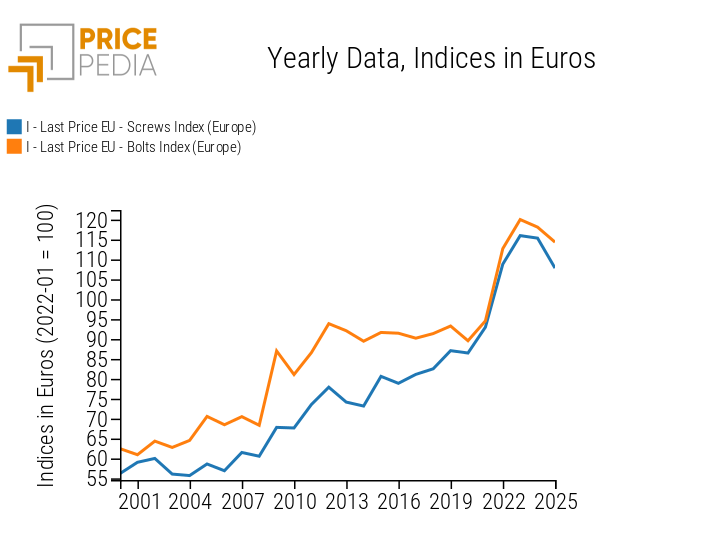Prices of Screws and Bolts: Steadily Rising, Except for Rare Cases Like the 2024–2025 Biennium
The slowdown of the European industrial cycle is reflected in lower prices for screws and bolts
Published by Luigi Bidoia. .
Ferrous Metals Price Drivers
The weakness of the European manufacturing sector — still about 3% below the peak reached at the end of 2022,
despite slight recoveries observed during 2025 — is also reflected in the prices of two product categories
that have historically shown limited and rarely negative variations:
screws and bolts.
The chart below shows the PricePedia price indices for these two product families.
To highlight the ongoing trend more clearly, the analysis considers annual average values for each index;
the 2025 figure represents the average for the first nine months of the year.
PricePedia price indices for screws and bolts

As shown in the chart, the decline in 2025 follows the one already recorded in 2024,
making the 2024–2025 biennium one of the few periods in which average prices for screws and bolts
have experienced significant reductions.
Over the long term, the price dynamics of these two product families display a
structurally upward trend
and a moderate correlation with the European industrial cycle.
The first regression analyses have not revealed any statistically significant relationships
with production cost trends.
At this stage, the main determinants of screw and bolt prices appear to stem from an
asymmetric mechanism:
prices tend to rise when demand or costs allow (or require) it,
but rarely decrease proportionally in the opposite conditions.
Except for a few cases — such as the current one —
competition tends to rely more on service levers
than on price adjustments.
To provide a quantitative assessment of recent trends, the following tables show the annual average prices of the main products within the screw and bolt families over the past five years.
Do you want to stay up-to-date on commodity market trends?
Sign up for PricePedia newsletter: it's free!
Screw Prices
The table below shows the annual average prices from 2019 to 2025 for five different types of screws, distinguished by the type of steel used and by the thread type.
Screw Prices (euro per ton)

Over the past six years, the price structure of screws has remained largely unchanged,
with wood screws positioned at the lowest price levels
and stainless steel self-tapping screws at the highest.
Not all screw categories reached their peak in 2023:
in particular, thread-forming screws and
self-tapping screws recorded their highest prices in 2024.
Compared with the peak, 2025 shows price declines ranging from
-5% for self-tapping screws
to -16% for stainless steel wood screws.
Bolt Prices
The following table presents the annual average prices from 2019 to 2025 for seven different types of bolts, classified by the type of steel used and by head geometry.
Bolt Prices (euro per ton)

For bolts as well, the relative price structure among the various types
has remained broadly stable:
recessed carbon steel bolts have the lowest prices,
while cross-head stainless steel bolts occupy the upper end of the range.
In the latest market cycle, the highest prices were reached in 2023,
with the exception of cross-head bolts,
both carbon steel and stainless steel, whose prices increased in both 2024 and 2025.
For other bolt types, price reductions from their peak to 2025 are more pronounced
for recessed bolts
(-10% and -13%, depending on the steel grade)
and more moderate for hexagonal bolts
(-5% for carbon steel and -12% for stainless steel).
Summary
Screw and bolt prices exhibit asymmetric dynamics: they tend to rise when demand or cost conditions support it, while during periods of weak demand or lower costs they show downward rigidity and remain relatively stable.
The relative price structure within the two product families (types and materials) tends to remain unchanged, resulting in mostly parallel movements among different price categories.
In contrast to most years of this century, the past two years have seen significant price declines across all screw types analyzed and for the majority of bolts, except for cross-head bolts.


